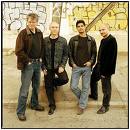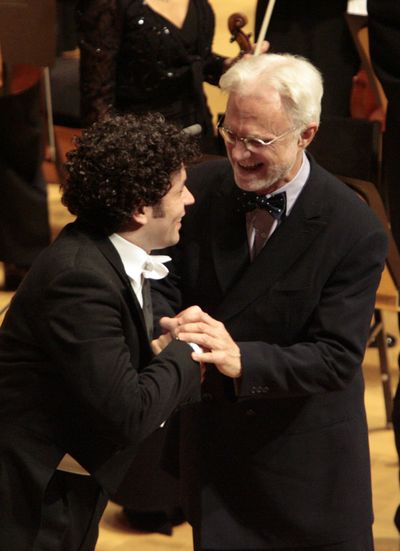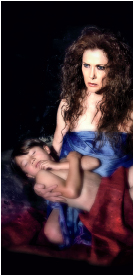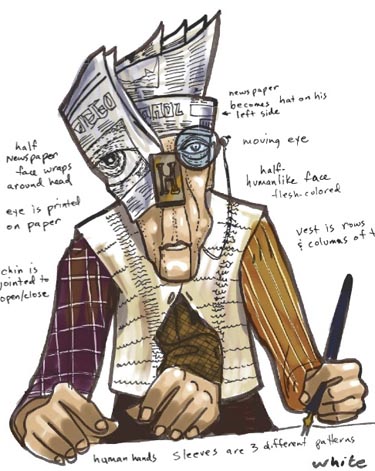 Perhaps the most interesting detail that came up in last night’s Theatre Critics’ Panel organized by Theatre Bay Area was the subject of presenting plays on unconventional days. Critics’ calendars tend to get very busy as the week moves towards the weekend. Thursday to Sunday nights are the fastest nights to get booked up with shows to see.
Perhaps the most interesting detail that came up in last night’s Theatre Critics’ Panel organized by Theatre Bay Area was the subject of presenting plays on unconventional days. Critics’ calendars tend to get very busy as the week moves towards the weekend. Thursday to Sunday nights are the fastest nights to get booked up with shows to see.
So one way of potentially increasing the chances of having a critic come and see a show as a producer, is by presenting it on a Monday and/or Tuesday. Intersection for the Arts and a couple of other companies have been in on this ruse for quite a while. Intersection for the Arts‘ upcoming opening night for The Erika Chong Shuch Performance Project & Campo Santo – The Future Project: Sunday Will Come – is happening next Monday, though performances ordinarily run from Thursdays through Saturdays (plus one Sunday). Very likely, most if not all the critics will be there on Monday, myself included, as Monday tends to be a free evening. Marine’s Memorial Theatre is going a step further by presenting the entire run of the first show in its its new New Works @ The Marines series — Rick Reynold’s Love, God, Sex (and other stuff I don’t have) only on Monday and Tuesday nights.
Then again, I wonder if audiences will generally be lured to go out to the theatre on a Monday night? Most people are kind of exhausted after the shock of the first day of the week. Monday Night Football probably seems like the most enticing option for many. Also, theatre critics have so little space these days to write about shows owing to the economic woes of the industry, that a Monday press night is not necessarily a guarantee at this point that the critics will show up.
Still, Monday night theatre is an interesting experiment. If I weren’t a professional critic, I think I’d prefer going out to see shows on unorthodox evenings like Monday or Tuesday. Friday and Saturday are not such a draw for me. Tickets are more expensive at the weekends and bars and restaurants are more crowded. There might be a place for Monday night theatre for anyone who feels the same way.

 One of the least satisfying musical experiences I think I’ve ever had was catching Bob Dylan at the Greek Theatre in Berkeley in 2002. This is really saying something as the combination of Great Bob and the Greek ought to have been a recipe for perfection. But the singer sadly failed to deliver. He played the piano badly, slurred and bleated his words more than I’ve ever heard him do previously and generally made every song sound unintelligible. My friend and I spent the entire gig playing a game of “guess which famous Bob Dylan song the singer is singing right now?” More often than not, we couldn’t make out the titles of his most beloved hits until the songs were halfway through.
One of the least satisfying musical experiences I think I’ve ever had was catching Bob Dylan at the Greek Theatre in Berkeley in 2002. This is really saying something as the combination of Great Bob and the Greek ought to have been a recipe for perfection. But the singer sadly failed to deliver. He played the piano badly, slurred and bleated his words more than I’ve ever heard him do previously and generally made every song sound unintelligible. My friend and I spent the entire gig playing a game of “guess which famous Bob Dylan song the singer is singing right now?” More often than not, we couldn’t make out the titles of his most beloved hits until the songs were halfway through.
 It’s been a fiendish day what with hangovers and three hours of sleep to contend with. On the positive side, these signs point to the fact that Gustavo Dudamel’s debut at Walt Disney Concert Hall as the
It’s been a fiendish day what with hangovers and three hours of sleep to contend with. On the positive side, these signs point to the fact that Gustavo Dudamel’s debut at Walt Disney Concert Hall as the  Radio presenters — especially ones engaged in hosting cultural programs — are very particular about the way they pronounce proper nouns. This is of course very important: You have to get names right or you risk causing offense to the bearer of the noun in question and/or being completely misunderstood by listeners.
Radio presenters — especially ones engaged in hosting cultural programs — are very particular about the way they pronounce proper nouns. This is of course very important: You have to get names right or you risk causing offense to the bearer of the noun in question and/or being completely misunderstood by listeners. Never before have I been in a theatre with so many sleeping people.
Never before have I been in a theatre with so many sleeping people. The people of the
The people of the  Just about every minute of the five hours I spent sitting in the nosebleeds at the Hollywood Bowl in Los Angeles was worth the one and a half hour slog in the broiling heat I undertook to reach the venue from my friend’s place in West Hollywood on Saturday afternoon. The occasion — Gustavo Dudamel’s inaugural appearance as music director of the
Just about every minute of the five hours I spent sitting in the nosebleeds at the Hollywood Bowl in Los Angeles was worth the one and a half hour slog in the broiling heat I undertook to reach the venue from my friend’s place in West Hollywood on Saturday afternoon. The occasion — Gustavo Dudamel’s inaugural appearance as music director of the  The first ever
The first ever  Tomorrow, – October 2 from 9AM-1PM PDT – The Annenberg School of Journalism, USC, is hosting its first ever National Summit on Arts Journalism. The summit will present ten projects in arts journalism from around America, each one geared towards saying something interesting about the future of how we cover the arts. The event will take place in the auditorium of the journalism school in front of an audience of 200 (I’ll be there!), but it’s primarily conceived of as a virtual online event. The Summit will be streamed
Tomorrow, – October 2 from 9AM-1PM PDT – The Annenberg School of Journalism, USC, is hosting its first ever National Summit on Arts Journalism. The summit will present ten projects in arts journalism from around America, each one geared towards saying something interesting about the future of how we cover the arts. The event will take place in the auditorium of the journalism school in front of an audience of 200 (I’ll be there!), but it’s primarily conceived of as a virtual online event. The Summit will be streamed 
 I had the privilege of catching an hour or so of mezzo-soprano Stephanie Blythe’s masterclass at the
I had the privilege of catching an hour or so of mezzo-soprano Stephanie Blythe’s masterclass at the